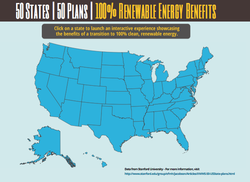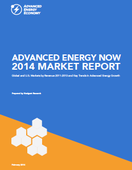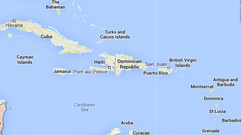

|
|
 Based on data from Stanford University, a new study presents roadmaps for each of the 50 United States to convert their all-purpose energy infrastructure(for electricity, transportation, heating/cooling, industry) to ones derived entirely from wind, water, and solar (WWS) power generating electricity and electrolytic hydrogen after energy efficiency measures are accounted for. The numbers of devices, footprint and spacing areas,energy costs, numbers of jobs, air pollution and climate benefits, and policies needed forthe conversions are provided for each state. The plans contemplate all new energy powered with WWS by 2020, about 80-85% of existing energy replaced by 2030,and 100% replaced by 2050.
 The Advanced Energy Now 2014 Market Report is the first annual report of market size, by revenue, of the advanced energy industry, worldwide and in the United States. As defined by Advanced Energy Economy (AEE), a national association of business leaders with the goal of making the global energy system more secure, clean, and affordable, advanced energy is a broad range of technologies, products, and services that constitute the best available technologies for meeting energy needs today and tomorrow. Prepared for AEE by Navigant Research, Advanced Energy Now 2014 reports that, for 2013, advanced energy reached $1.13 trillion in estimated global revenue, a 7% increase year-over-year driven by growth in six of the seven segments. Fluctuation in the worldwide total for advanced energy was largely driven by a peak year for large hydro projects in 2011 followed by a large decline in 2012, then slow growth in 2013. In the United States, the advanced energy market was an estimated $168.9 billion in 2013, 15% of the global advanced energy market, up from 11% in 2011. Excluding wind, U.S. advanced energy revenue grew 18% from 2011 to 2012 and 14% from 2012 to 2013. Wind energy suffered a severe, $23 billion revenue downward swing between 2012 and 2013, due to policy uncertainty around the federal Production Tax Credit (PTC). The effect of wind’s downturn is that U.S. advanced energy revenue declined 2% overall in 2013, following a 26% increase from 2011 to 2012.  Caribbean nations, including St. Lucia, Turks and Caicos and the British Virgin Islands, committed last week to start replacing diesel generators, the most common means of producing electricity on islands, with renewable sources like wind, solar or geothermal. Because diesel must be imported, the cost of electricity on the islands is generally very high, which makes renewable alternatives economically as well as environmentally attractive. The countries signed the pact at a multiday meeting organized by the Carbon War Room, a nonprofit organization that Richard Branson, the billionaire founder of the Virgin Group, established to fight climate change. More here. Brazil: Presidential Candidate Proposes Clean Energy Incentives in Run Up to October 2014 Election2/5/2014
 Brazilian presidential candidate, Eduardo Campos, proposed incentives for renewable energy in a set of guidelines outlining his new coalition’s policies. The guidelines include tax, fiscal and credit incentives to spur wider use of clean energy, according to Bloomberg. Campos is currently the governor of Pernambuco state, which held Brazil's first solar-only auction in December 2013. Former environment minister Marina Silva, best known as a champion for conservation of the Amazon forest, forged an alliance in October 2013 with Campos’s Brazilian Socialist Party. |
Categories
All
Archives
January 2025
Blogroll
|
|
© 2013 - 2025 InterAmerican Clean Energy Institute, a project of Earth Ways Foundation Inc, a 501(c)3 nonprofit organization.
|
Web Hosting by iPage
|
 RSS Feed
RSS Feed